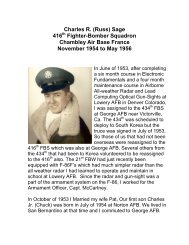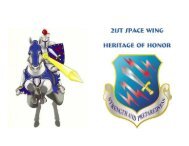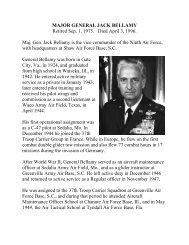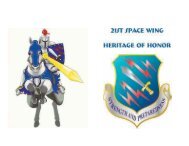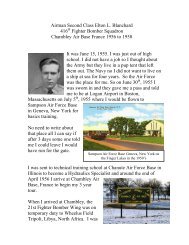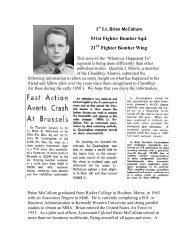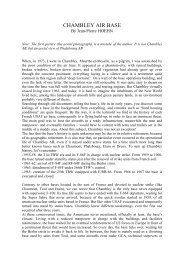21st Space Wing/History - Chambley Air Base France Home Pages
21st Space Wing/History - Chambley Air Base France Home Pages
21st Space Wing/History - Chambley Air Base France Home Pages
Create successful ePaper yourself
Turn your PDF publications into a flip-book with our unique Google optimized e-Paper software.
The <strong>21st</strong> Tactical Fighter <strong>Wing</strong><br />
Colonel Nelson continued as commander, helping to transition the wing into its new fighter role. The mixed bag<br />
of aircraft from the old Composite <strong>Wing</strong> dispersed, leaving 40 F-4Es, 12 T-33s, and a C-12 at Elmendorf AFB, Alaska. The<br />
F-4s were distributed between the wing’s two flying components, the 18th and 43d Tactical Fighter Squadrons, while the<br />
T-33 trainers and the C-12 merged into the 50<strong>21st</strong> Tactical Operations Squadron.<br />
The F-4s of the streamlined wing soon deployed to Chong Ju <strong>Air</strong> <strong>Base</strong>, Republic of Korea for Exercise “TEAM<br />
SPIRIT.” During March 1980 the wing participated in dissimilar air combat training (DACT) and conducted combat air<br />
patrol, air interdiction and composite force tactics. TEAM SPIRIT proved to be the last exercise for the <strong>21st</strong>’s F-4s.<br />
Later that year the <strong>Air</strong> Force released plans to replace the F-4Es stationed in Alaska with F-15A fighters, which<br />
were slated to go to the 43d Tactical Fighter Squadron, and A-10 close air support aircraft, which were earmarked for the<br />
18th Tactical Fighter Squadron. In fact, the arrival of the A-10s heralded the reassignment of the 18th from the <strong>21st</strong> to the<br />
343d Composite <strong>Wing</strong> at Eielson AFB, Alaska.<br />
The first F-15 arrived at Elmendorf in March, and the last of the new aircraft were in place by October. Thanks to<br />
special bomb-delivery air-to-surface training carried out in the T-33s, the <strong>21st</strong> Tactical Fighter <strong>Wing</strong> became the first flying<br />
unit to reach initial operating capability (IOC) in the F-15 without the assistance of the aircraft manufacturer or a sister<br />
flying unit. The <strong>21st</strong> made its first intercept of a Soviet intruder, a Tu-95 Bear C, when a pair of F-15s sortied from alert at<br />
King Salmon <strong>Air</strong>port on 24 November 1982.<br />
Over the next four years, the F-15s undertook several deployments and exercises such as “BRIM FROST,” a U.S.<br />
Readiness Command biennial Arctic exercise, and “TEAM SPIRIT” held in Japan and the Republic of Korea in 1985. The<br />
<strong>21st</strong> conducted joint training exercises along the northern continental frontier with the Canadians. All the while, the wing<br />
intercepted Soviet bomber, transport, and maritime reconnaissance aircraft flying over the Arctic Ocean and Bering Sea.<br />
This creditable service continued throughout the late 1980s from the William Tell <strong>Air</strong>-to-<strong>Air</strong> Weapons meets to<br />
COMBAT ARCHER to DACT training to the <strong>Air</strong> Force’s “live-fire” Weapon System Evaluation Programs. During one<br />
exercise at the remote site known as Deadhorse, Alaska, three F-15s became the first Alaskan-based single-seat fighters to<br />
circle the North Pole. The <strong>21st</strong> received newer aircraft, its first F-15Cs and Ds, in May 1987.<br />
The wing hosted multiple distinguished visitors in 1989. President George Bush stopped at Elmendorf in route to<br />
Japan for the state funeral of Japanese Emperor Hirohito and addressed a crowd of over 7,000 in Hangar Five. Ironically,<br />
this was the same hangar in which President Richard Nixon had greeted Hirohito eighteen years previously when the<br />
emperor had made his first official state visit outside his native land.<br />
Later that year, the wing expanded into the escort rather than only the intercept business. Two Soviet MiG-29<br />
“Fulcrum” aircraft, which were traveling to their first air show in North America, officially visited the <strong>21st</strong> at Elmendorf,<br />
not only to refuel, but as a gesture of goodwill. This event marked the first time the MiG-29 fighters landed on the<br />
continent, and the <strong>21st</strong>’s aircraft were there to escort them in, help them refuel, and play host.<br />
The final upgrade of the <strong>21st</strong> fighter inventory came with the addition of the 90th Tactical Fighter Squadron and<br />
the famous F-15E “Strike Eagle” in May 1991. The wing scarcely had completed pilot training on the new fighter-bomber<br />
when word of the <strong>Air</strong> Force Restructuring Program hit the Alaskan theater. The <strong>Air</strong> Force directed each base to have one<br />
wing and one commander; consequently, the wings of Alaskan <strong>Air</strong> Command consolidated aircraft, personnel and resources<br />
under one wing, the 3rd at Elmendorf. Although out of the business of flying, the <strong>21st</strong> soon transitioned into the<br />
cutting edge of military operations - space.



